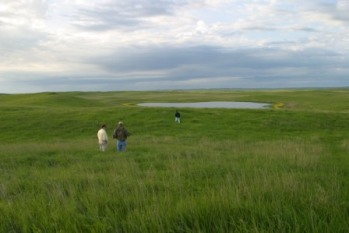
Agricultural News
USDA Enrolls 800,000 Acres into the Conservation Reserve Program in the 49th Sign Up Period of This Legacy Program
Thu, 05 May 2016 12:31:46 CDT
 Agriculture Secretary Tom Vilsack today announced the enrollment of more than 800,000 acres in the Conservation Reserve Program (CRP) through the program's 49th sign up period. Through CRP, the U.S. Department of Agriculture (USDA) helps farmers offset the costs of restoring, enhancing and protecting certain grasses, shrubs and trees that improve water quality, prevent soil erosion and strengthen wildlife habitat. Farmers' and ranchers' participation in CRP continues to provide numerous benefits to our nation, including helping reduce emissions of harmful greenhouse gases and providing resiliency to future weather changes.
Agriculture Secretary Tom Vilsack today announced the enrollment of more than 800,000 acres in the Conservation Reserve Program (CRP) through the program's 49th sign up period. Through CRP, the U.S. Department of Agriculture (USDA) helps farmers offset the costs of restoring, enhancing and protecting certain grasses, shrubs and trees that improve water quality, prevent soil erosion and strengthen wildlife habitat. Farmers' and ranchers' participation in CRP continues to provide numerous benefits to our nation, including helping reduce emissions of harmful greenhouse gases and providing resiliency to future weather changes.
"The Conservation Reserve Program provides nearly $2 billion annually to land owners dollars that make their way into local economies, supporting small businesses and creating jobs. When these direct benefits are taken together with the resulting economic activity, the benefits related to CRP are estimated at $3.1 billion annually," said Vilsack. "Over the past 30 years, CRP has created major environmental improvements throughout the countryside. The program has removed carbon dioxide from the atmosphere equal to removing nine million cars from the road annually, and prevented 600 million dump trucks of soil from erosion. With today's announcement, USDA is continuing these achievements by maximizing conservation benefits within the limitations provided by law."
This was one of the most selective sign-up periods in CRP's 30-year history, with a record high Environmental Benefits Index cut-off and the lowest-percentage of applications accepted. The high bar means that the per-acre conservation benefits are being maximized and that acres enrolled address multiple conservation priorities simultaneously.
A nationwide acreage limit was established for this program in the 2014 Farm Bill, capping the total number of acres that may be enrolled at 24 million for fiscal years 2017 and 2018. At the same time, USDA has experienced a record demand from farmers and ranchers interested in participating in the voluntary program. As of March 2016, 23.8 million acres were enrolled in CRP, with 1.7 million acres set to expire this fall.
Over three million acres have been offered for enrollment this year across the three main categories within CRP, with USDA's Farm Service Agency (FSA) receiving over 26,000 offers to enroll more than 1.8 million acres during the general enrollment period, and over 4,600 offers to enroll more than one million acres in the new CRP Grasslands program. Coming off a record-setting 2015 continuous enrollment of over 860,000 acres, more than 364,000 acres already have been accepted for 2016 in the CRP continuous enrollment, triple the pace of last year.
FSA will accept 411,000 acres in general enrollment, the most competitive selection in in the history of the program, with the acreage providing record high conservation benefits. USDA selected offers by weighing environmental factors plus cost, including wildlife enhancement, water quality, soil erosion, enduring benefits, and air quality.
The results of the first-ever enrollment period for CRP Grasslands, FSA will also accept 101,000 acres in the program, providing participants with financial assistance for establishing approved grasses, trees and shrubs on pasture and rangeland that can continue to be grazed. More than 70 percent of these acres are diverse native grasslands under threat of conversion, and more than 97 percent of the acres have a new, veteran or underserved farmer or rancher as a primary producer. FSA continues to accept CRP Grasslands offers and will conduct another ranking period later this year. Acres are ranked according to current and future use, new and underserved producer involvement, maximum grassland preservation, vegetative cover, pollinator habitat and various other environmental factors.
Participants in CRP establish long-term, resource-conserving plant species, such as approved grasses or trees (known as "covers") to control soil erosion, improve water quality and develop wildlife habitat on marginally productive agricultural lands. In return, FSA provides participants with rental payments and cost-share assistance. Contract duration is between 10 and 15 years.
CRP is currently protecting more than 100,000 acres of bottomland hardwood trees, nearly 300,000 acres of flood-plain wetlands, and 300,000 acres each for duck nesting habitat and nearly 250,000 acres of upland bird habitat. In addition, CRP is creating economic benefits that include at least $545 million per year in recreation benefits and water quality benefits from reduced sedimentation of $587 million per year.
Throughout the Obama Administration, USDA has generated thousands of critical partnerships to conserve and protect our natural resources on working landscapes, while enrolling a record number of acres in conservation programs. Seventy-percent of the nation's land is owned and tended to privately, and America's farmers, ranchers and landowners have willingly stepped up to address the growing impacts of a changing climate. With USDA's support, they work to implement voluntary practices that improve air and water quality, prevent soil erosion and create and protect wildlife habitat.
Since 2009, USDA has invested more than $29 billion to help producers make conservation improvements, working with as many as 500,000 farmers, ranchers and landowners to protect land and water on over 400 million acres nationwide.
To learn more about the CRP and other Conservation programs of USDA, Click here.
Source: USDA
WebReadyTM Powered by WireReady® NSI
Top Agricultural News
More Headlines...





